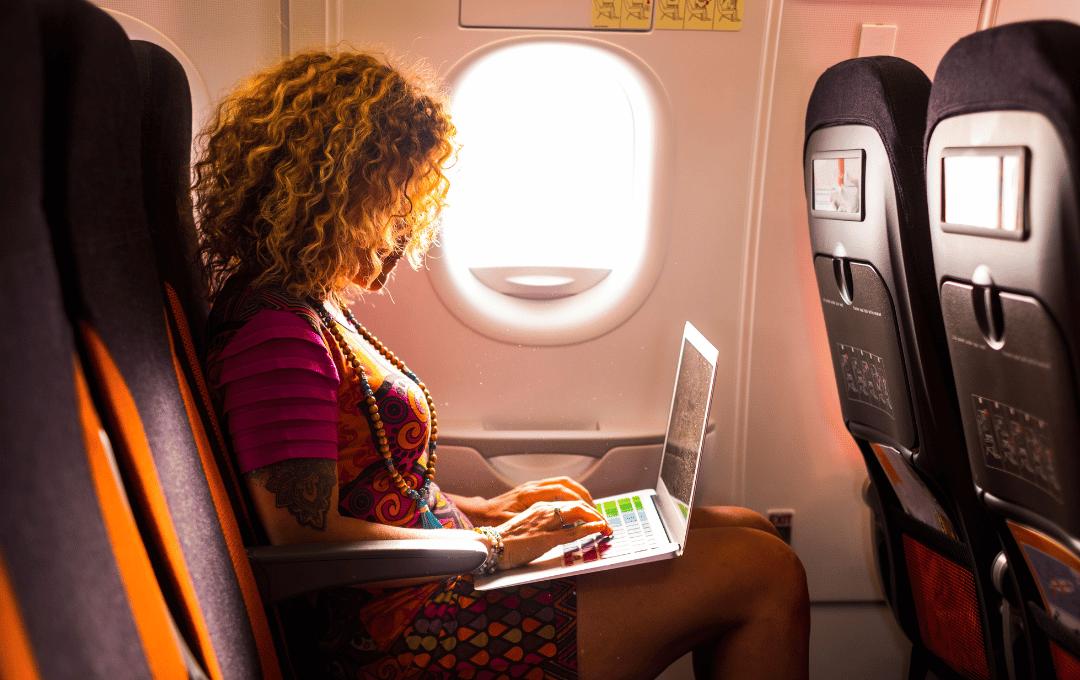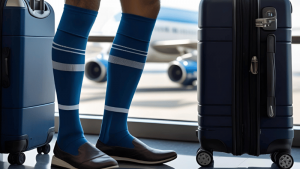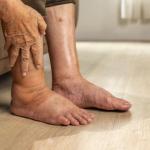
If you have varicose veins, several factors can exacerbate the appearance and symptoms of the veins. Flying is a perfect example. You sit for long periods at the terminal gate and on the plane, which can increase your risk of developing a blood clot.
If you’re planning on flying with varicose veins and are concerned about how they might affect your travel experience, this blog explores common questions like:
- Can you fly with varicose veins?
- Is it dangerous to fly with varicose veins?
We’ll also cover how to reduce discomfort, when to put on compression socks for flying, and when to seek medical care before or after air travel.
Why This Matters
Blood clotting is a natural process in the human body that aids in healing, but varicose veins may trigger this response in an attempt to repair permanently damaged vein valves, causing the vein to swell and bulge. If this damage happens in a larger, deeper vein and a blood clot forms, it could potentially threaten the person’s life.
Understanding the risk factors that can lead to blood clot formation, such as flying with varicose veins, can prompt a person to take proactive measures to reduce the risk of developing a potentially dangerous blood clot.
Can You Fly With Varicose Veins?
It is generally safe to fly with varicose veins as long as you take a few simple precautions to avoid complications. However, it’s still recommended to consult a vein specialist beforehand, particularly if you’ve experienced discomfort during past flights or from other vein-related issues such as a history of blood clots, , or significant leg swelling.
Is It Dangerous to Fly With Varicose Veins?
While flying with varicose veins is not usually a danger, it is essential to be aware of any potential risks. Prolonged sitting during flights can slow down blood circulation, potentially leading to the formation of clots inside the veins. Additionally, a history of blood clots, obesity, or smoking further increases this risk.
In rare situations, a clot can form in a deeper vein—a condition known as deep vein thrombosis (DVT). DVT is a more serious concern because it can lead to a .
Varicose veins may also be a sign of an underlying condition called chronic venous insufficiency (CVI), a form of vein disease in which the valves in the veins are weakened or damaged, allowing blood to flow back to the heart less efficiently than it should. When this underlying condition is present, prolonged periods of sitting during travel can make symptoms worse.
Individuals with severe vein disease or a history of DVT may face greater discomfort or risk while flying and should take extra precautions, such as consulting with a vein specialist.
Does Flying Make Varicose Veins Worse?
Flying can make varicose vein symptoms worse, especially on longer trips. Sitting for an extended period can impair blood flow in the legs, increasing the risk of swelling, throbbing, or even cramping. Cabin pressure and dry air might contribute to discomfort, although there isn’t enough evidence to suggest these factors alone make varicose veins worse. In some cases, flying may trigger thrombophlebitis, a condition where a superficial vein becomes inflamed due to a clot, or increase the risk of DVT in vulnerable patients. Following proper precautions before, during, and after a long flight is crucial for managing varicose vein symptoms.
Can Flying Cause Varicose Veins?
Flying itself does not cause varicose veins; they develop due to underlying risk factors, such as genetics, age, pregnancy, obesity, and prolonged standing or sitting.
The primary connection between flying and varicose veins is that prolonged periods of immobility, such as those experienced during a long flight, can exacerbate pre-existing vein issues, especially in individuals at risk.
Tips for Flying With Varicose Veins
Flying with varicose veins doesn’t have to be uncomfortable. These tips can help manage symptoms and reduce your risk of blood clots when traveling with varicose veins.
Before Your Flight
If you’re worried about flying and varicose veins, here are a few things you can do before takeoff:
- Discuss your travel plans with a vein specialist beforehand for tips on flying with varicose veins.
- Book an aisle seat to make getting up and moving around easier, if possible.
- Wear loose, breathable clothing; tight clothing restricts circulation.
- Wear compression socks (as per your doctor’s orders) to boost circulation during the flight.
During Your Flight
- Stay hydrated with water to promote healthy blood flow.
- Try ankle circles, foot flexes, or taking bathroom breaks to move around.
- Avoid alcohol and salty foods that may cause dehydration and swelling.
- Keep your body cool, as heat may aggravate swelling and discomfort.
- Wear compression socks for added support during the flight.
When to Put On Compression Socks for Flying
Compression socks or stockings are great to have on long flights, as they apply gentle pressure to your legs, supporting vein function and reducing swelling and discomfort. When flying, it’s recommended to put compression socks on before takeoff, not after the flight has started. If you wait until the flight starts, your legs may already begin swelling, making the compression socks less effective.
While compression stockings can be helpful when flying with varicose veins, they aren’t for everyone. Compression socks are not recommended for people with severe health conditions like peripheral artery disease and heart disease. Healthy individuals may not need compression socks if they don’t fit properly, as they can actually do more harm than good.
Before a long flight, consider speaking with a doctor or a vein specialist to see if compression socks are recommended for your personal health. Proper fit is key to their effectiveness, so seeking professional guidance is always a good idea
Varicose Vein Pain After Flying: What to Know
You may notice varicose vein pain after flying, along with symptoms like throbbing, cramping, or swelling. These can result from prolonged immobility and changes in cabin pressure. While mild swelling may improve with rest and leg elevation, symptoms that persist or worsen after a flight could be a sign of more serious vein problems.
Monitor how your legs feel after traveling. If you experience pain that is new, consistent, or more severe than usual, consult a vein specialist.
When to Consult a Vein Specialist for Air Travel
If you’re worried about flying and varicose veins, it can be helpful to talk with a vein specialist well before a flight.
Before Flying With Varicose Veins
You should consider consulting a vein specialist before flying if you have:
- A history of blood clots or DVT
- Ongoing or chronic leg swelling
- Visible, bulging varicose veins
- A history of pain or discomfort while flying
After Flying With Varicose Veins
Additionally, it is recommended to see a specialist if you experience any of these symptoms after flying with varicose veins:
- New or worsening leg pain
- Swelling that doesn’t improve with rest
- New skin discoloration, irritation, or other changes
- A sense of heaviness or cramping in your legs that wasn’t present before
These may be signs of an underlying vein condition that requires medical evaluation. With nationwide locations, the specialists at USA Vein Clinics are here to help you with any concerns you may have.
Travel With Confidence: Specialized Vein Care at USA Vein Clinics
At USA Vein Clinics, we believe nothing should hold you back—not even varicose veins. Whether you’re planning a flight for vacation or work, or simply want to live without the discomfort of swollen, aching legs, our accredited facilities and minimally invasive treatments can help. We provide expert care designed to improve your vein health, offering lasting relief that supports an active life, at home or away.
Don’t let varicose veins ground your plans. Book a consultation with USA Vein Clinics today and move through life with confidence
Explore Varicose Vein Treatments
FAQs About Varicose Veins and Air Travel
Can You Fly After Varicose Vein Treatment?
It’s best to avoid flying after varicose vein treatment for at least 3-4 weeks, especially on long-haul flights (those exceeding 4 hours), as this can increase the likelihood of developing serious conditions. Consult your doctor for details tailored to your post-treatment care
Are Long Flights More Dangerous for People with Varicose Veins?
Flying with varicose veins isn’t inherently dangerous, but long flights can increase the likelihood of complications due to prolonged sitting.
Should I Cancel My Flight if I Have Sudden Leg Pain or Swelling Before Flying?
You may need to cancel your flight if you experience sudden leg pain and swelling prior to flying, especially if it’s isolated to one leg. These symptoms may indicate a blood clot that needs immediate medical attention.






